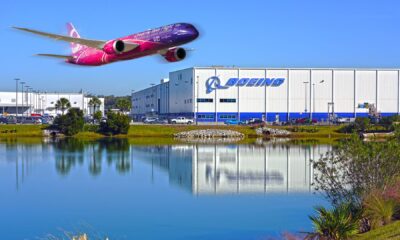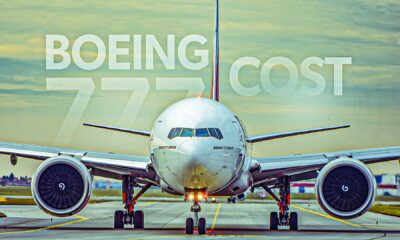World
Boeing Develops New Technology to Combat Turbulence Risks

Boeing has taken significant steps to address the ongoing challenge of turbulence in commercial aviation by filing two innovative patents aimed at enhancing safety and navigation. With reports indicating tens of thousands of turbulence events occur yearly, the company is focusing on technologies that could potentially reduce the risks associated with this common flight hazard.
Innovative Turbulence Mitigation Technologies
The patents, titled **US4258823A** and **EP1842081A2**, detail Boeing’s approach to turbulence mitigation through advanced systems for detection and airflow control. These developments come amid rising turbulence incidents and are particularly crucial as experts predict an increase in turbulence due to climate change. One of the patents, named the **System for Measuring Turbulence Remotely**, utilizes advanced electromagnetic sensors to provide pilots with enhanced warnings of impending turbulence. This system is designed to create a real-time, three-dimensional map of turbulence, allowing for more informed navigation decisions.
The second patent, known as the **Inflow Turbulence Control Structure**, focuses on improving engine and airframe testing. By recreating in-flight conditions on the ground, Boeing aims to enhance the accuracy of testing data, ensuring that aircraft are better equipped to handle turbulence during actual flights.
Enhancing Weather Prediction and Safety
Boeing’s initiative also includes integrating satellite data with its electromagnetic-based system to improve the accuracy of turbulence predictions. Current weather and radar networks are effective but can miss areas with limited coverage. The proposed **System for Measuring Turbulence Remotely** aims to measure electromagnetic signal changes to provide a clearer picture of weather conditions, filtering out interference from aircraft movement and atmospheric factors. This data would be shared in real-time with other aircraft and air traffic control, forming a network that could revolutionize turbulence prediction.
As turbulence remains a leading cause of injury in commercial aviation, enhancing detection systems is vital for passenger safety. According to the National Transportation Safety Board (NTSB), turbulence was a significant factor in over one-third of all scheduled commercial air accidents from 2009 to 2018, highlighting the need for improved technology in this area.
Industry-Wide Efforts to Combat Turbulence
Boeing is not alone in its quest to tackle turbulence; other major players, such as Airbus, are also advancing technology to enhance turbulence awareness. Airbus is developing a **Turbulence EDR (Eddy Dissipation Rate)** system that uses onboard sensors to detect turbulence and relay reports across a global network. This collaborative approach aims to provide pilots with critical time to prepare for turbulence, ultimately improving safety.
Artificial intelligence (AI) is increasingly being integrated into aviation technology as well. A partnership between All Nippon Airways (ANA) and BlueWX is producing an AI-based system that has achieved an impressive **86% detection rate** for turbulence, using deep learning and user feedback to refine its predictions.
The Importance of Turbulence Detection
While modern weather monitoring systems can identify many adverse weather patterns, some turbulence, particularly **clear air turbulence (CAT)**, remains challenging to predict accurately. Enhanced detection systems are essential not only for safety but also for operational efficiency. Turbulence can lead to costly diversions and delays, making smarter navigation decisions increasingly vital for airlines.
Passengers are often reminded to remain seated with seatbelt signs activated when turbulence is anticipated. Loose items should be stowed away to minimize injury risks during turbulence events. While severe turbulence is rare, it can lead to significant injuries, including broken bones and head trauma, as observed in recent incidents.
Recent Turbulence Incidents Highlight Risks
Incidents of severe turbulence have been on the rise, further emphasizing the need for improved detection and mitigation strategies. For instance, in **July 2025**, a **Delta Air Lines** flight from Salt Lake City to Amsterdam encountered turbulence, resulting in **25 hospitalizations** and numerous minor injuries. Similar incidents have occurred with **Air France** and **IndiGo**, underscoring the ongoing threat turbulence poses to passenger safety.
In **May 2024**, a tragic incident involving a **Singapore Airlines** flight marked the first turbulence-related death in over 25 years, as an elderly passenger suffered a fatal heart attack during severe turbulence. With predictions indicating a potential doubling or tripling of severe turbulence incidents in the coming decades, developing effective detection and mitigation technologies is imperative for the aviation industry.
As Boeing and other industry leaders advance their efforts to combat turbulence, the focus remains on enhancing passenger safety, improving navigation, and reducing operational costs associated with turbulence events. The integration of innovative technologies will be instrumental in shaping a safer flying experience for passengers worldwide.
-

 World4 months ago
World4 months agoScientists Unearth Ancient Antarctic Ice to Unlock Climate Secrets
-

 Entertainment4 months ago
Entertainment4 months agoTrump and McCormick to Announce $70 Billion Energy Investments
-

 Lifestyle4 months ago
Lifestyle4 months agoTransLink Launches Food Truck Program to Boost Revenue in Vancouver
-

 Science4 months ago
Science4 months agoFour Astronauts Return to Earth After International Space Station Mission
-

 Technology2 months ago
Technology2 months agoApple Notes Enhances Functionality with Markdown Support in macOS 26
-

 Top Stories3 weeks ago
Top Stories3 weeks agoUrgent Update: Fatal Crash on Highway 99 Claims Life of Pitt Meadows Man
-

 Sports4 months ago
Sports4 months agoSearch Underway for Missing Hunter Amid Hokkaido Bear Emergency
-

 Politics3 months ago
Politics3 months agoUkrainian Tennis Star Elina Svitolina Faces Death Threats Online
-

 Politics4 months ago
Politics4 months agoCarney Engages First Nations Leaders at Development Law Summit
-

 Technology4 months ago
Technology4 months agoFrosthaven Launches Early Access on July 31, 2025
-

 Top Stories1 week ago
Top Stories1 week agoFamily Remembers Beverley Rowbotham 25 Years After Murder
-

 Entertainment4 months ago
Entertainment4 months agoCalgary Theatre Troupe Revives Magic at Winnipeg Fringe Festival


















